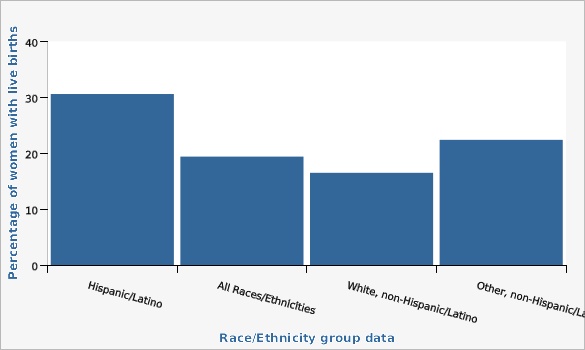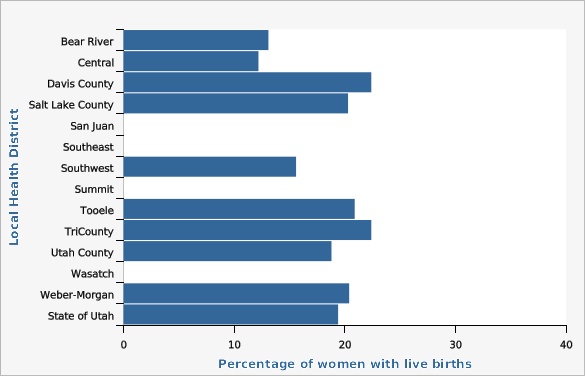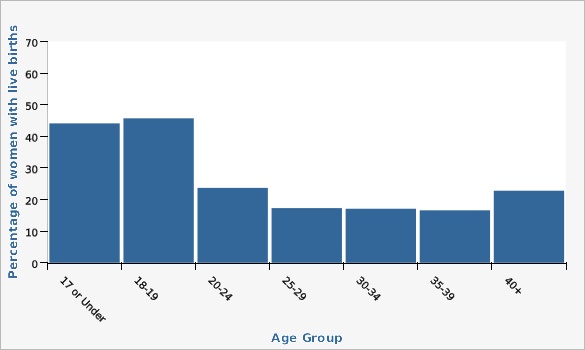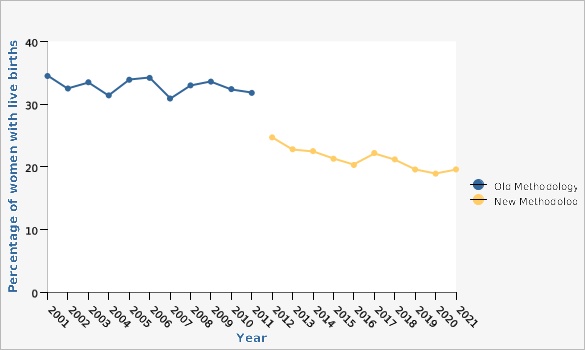Complete Health Indicator Report of Births from unintended pregnancies
Definition
Percentage of Utah women with live births who reported their most recent pregnancy was unintended.Numerator
Number of unintended births among Utah women.Denominator
Number of Utah women with a live birth.Data Interpretation Issues
A stratified random sampling approach is used in selecting women 2-4 months postpartum to participate in PRAMS. The data are weighted by the CDC to represent the birth population for that year, adjusted for sampling probabilities, nonresponse, and noncoverage. Each stratum must achieve a weighted response rate of 50% or it is not considered representative of that population. See the PRAMS website at [http://www.cdc.gov/prams/methodology.htm] for more detailed information on PRAMS and its methodology.Why Is This Important?
In the United States, unintended pregnancy is a major public health concern. Unintended pregnancy is a general term that includes pregnancies a woman reports were either mistimed or unwanted at the time of conception. Women with unintended pregnancies are less likely to seek early prenatal care or receive adequate prenatal care, they are more likely to smoke or drink during pregnancy, and are less likely to initiate or maintain breastfeeding.Healthy People Objective FP-1:
Increase the proportion of pregnancies that are intendedU.S. Target: 56.0 percent
Other Objectives
Similar to HP2030 Objective FP-1: Reduce the proportion of unintended pregnancies among women aged 15-44. The 2013 baseline for this objective is 43.0% with a target of 36.5%. As the PRAMS survey is only administered to women with a recent live birth and is not used as a data source for this HP2030 Objective, PRAMS data cannot be used as a direct comparison of Utah's status on this objective. Similar to HP2030 Objective FP-10: Increase the proportion of women at risk for unintended pregnancy who use effective birth control.How Are We Doing?
During the years 2019-2021, 19.4% of Utah women reported that their birth resulted from unintended pregnancy.How Do We Compare With the U.S.?
National PRAMS data in 2019 and 2020, the latest data available, show that 26.3% of women reported that their birth resulted from unintended pregnancy.What Is Being Done?
To reduce unplanned pregnancies, public health efforts may include: Health Education: Increase knowledge of human reproduction, conception, and proper use of available contraceptive methods, and promote optimal spacing of pregnancies for healthy maternal and infant outcomes. Women's health and maternal health information and education are available from the Utah Department of Health Human Services Maternal and Infant Health Program at https://mihp.utah.gov/. Preconception and interpregnancy health information are available from the Utah Department of Health and Human Services at http://poweryourlife.org/. Follow Power Your Life on: Facebook: https://www.facebook.com/poweryourlifeut/ Instagram: https://www.instagram.com/poweryourlifeut Access to family planning services: Family planning services are available in Utah from several sources: community health centers, Planned Parenthood Association of Utah clinics, Family Planning Elevated, and private providers. Utah law requires unmarried minors' parental consent to obtain contraception information and services from community health centers and clinics. Self-administered hormonal contraceptives are available directly from a pharmacist. People 18 years and older can receive their birth control pills, patch or ring directly from a participating pharmacist. For more information, call your pharmacy or see [https://mihp.utah.gov/birthcontrol]. As of August 1, 2012, non-grandfathered plans must provide coverage for preventive women's health care, including contraception and counseling, without cost-sharing. Medicaid also provides family planning counseling and FDA-approved contraceptive methods without cost-sharing.Evidence-based Practices
Various studies have indicated that the use of long-acting reversible contraceptive (LARC) devices such as Implants and Intrauterine Devices (IUD) effectively lower the incidence of unplanned pregnancy in population and clinic settings.Available Services
Family planning services are available in Utah from several sources: community health centers, Planned Parenthood Association of Utah clinics, Family Planning Elevated, private providers, and pharmacies. Utah law requires unmarried minors' parental consent to obtain contraception information and services from community health centers and clinics. Utah law allows pharmacies to dispense (through a statewide standing order issued by the Utah Department of Health and Human Services) or prescribe three contraception types - pills, patch, or ring. People 18 years and older can go to any participating pharmacy to receive their pills, patch, or ring directly from the pharmacist. For more information, see https://mihp.utah.gov/birthcontrol. As of August 1, 2012, non-grandfathered plans and Medicaid provide coverage for preventive women's health care, including contraception and counseling, without cost-sharing. Begining January 1, 2022, a pharmacist my prescribe self-administered hormonal contraception - pills, patch, or ring - to people 18 years and older. Call your pharmacy for more information. Women's health and maternal health information and education are available from the Utah Department of Health and Human Services Maternal and Infant Health Program at https://mihp.utah.gov/. Preconception and interpregnancy health information are available from the Utah Department of Health and Human Services at http://poweryourlife.org/. Follow Power Your Life on: Facebook: https://www.facebook.com/poweryourlifeut/ Instagram: https://www.instagram.com/poweryourlifeutRelated Indicators
Relevant Population Characteristics
Women less than 20 years of age, those with less than a high school education, race other than White, Hispanic ethnicity, being unmarried, annual income less than $15,000, no health insurance or Medicaid before pregnancy, smoked or drank in three months before pregnancy, and those who had a baby within 20 months of the current pregnancy are more likely to report an unintended pregnancy.Related Relevant Population Characteristics Indicators:
Health Care System Factors
Family planning services are available in Utah from several sources: community health centers, Planned Parenthood Association of Utah clinics, Family Planning Elevated, and private providers and pharmacies. Utah law requires unmarried minors' parental consent to obtain contraception information and services from community health centers and clinics.Related Health Care System Factors Indicators:
Risk Factors
Having an unintended pregnancy can contribute to short inter-pregnancy spacing, the timing between a live birth and the next pregnancy, which increases the risk of preterm birth, low birth weight, and small for gestational age infants. Research has shown that short intervals (less than 18 months) and long intervals (60+ months) were associated with a higher risk of negative health outcomes for mothers and babies. 2021 birth data finds 33% of Utah mothers became pregnant less than 18 months after their last birth.Health Status Outcomes
Unintended pregnancies are associated with: * Delayed prenatal care and poor health in pregnancy * Preterm birth * Increased morbidity in women with chronic medical conditions * Increased risk of maternal depressionGraphical Data Views
| Local Health District | Percentage of women with live births | Lower Limit | Upper Limit | Note | ||
|---|---|---|---|---|---|---|
Record Count: 14 | ||||||
| Bear River | 13.1% | 8.9% | 17.6% | |||
| Central | 12.2% | 4.9% | 19.3% | * | ||
| Davis County | 22.4% | 17.1% | 27.6% | |||
| Salt Lake County | 20.3% | 17.9% | 22.7% | |||
| San Juan | ** | ** | ||||
| Southeast | ** | ** | ||||
| Southwest | 15.6% | 10.1% | 21.1% | |||
| Summit | ** | ** | ||||
| Tooele | 20.9% | 9.9% | 31.8% | |||
| TriCounty | 22.4% | 10.4% | 34.4% | |||
| Utah County | 18.8% | 15.7% | 21.8% | |||
| Wasatch | ** | ** | ||||
| Weber-Morgan | 20.4% | 16.1% | 24.8% | |||
| State of Utah | 19.4% | 17.9% | 20.8% | |||
Data Notes
Question: "Thinking back to just before you got pregnant, how did you feel about becoming pregnant?" (check one answer). Answer Options: I wanted to be pregnant sooner, I wanted to be pregnant later, I wanted to be pregnant then, I didn't want to be pregnant then or at any time in the future, or I wasn't sure what I wanted. Women who wanted to be pregnant later or didn't want to be pregnant were categorized as having an unintended pregnancy. [[br]] [[br]]*Use caution when interpreting the estimate for Central LHD as it has a relative standard error greater than 30% which does not meet UDOH standards for reliability. **The estimates for San Juan, Southeast, Summit, and Wasatch have been suppressed as they have a relative standard error greater than 50% or less than 11 respondents which do not meet DHHS standards for reliability.Data Source
The Utah Department of Health and Human Services Pregnancy Risk Assessment Monitoring System (PRAMS)| Age Group | Percentage of women with live births | Lower Limit | Upper Limit | |||
|---|---|---|---|---|---|---|
Record Count: 7 | ||||||
| 17 or Under | 44.1% | 23.7% | 66.7% | |||
| 18-19 | 45.7% | 34.7% | 57.1% | |||
| 20-24 | 23.7% | 20.5% | 27.2% | |||
| 25-29 | 17.3% | 15.0% | 19.8% | |||
| 30-34 | 17.1% | 14.6% | 20.0% | |||
| 35-39 | 16.6% | 12.9% | 21.1% | |||
| 40+ | 22.8% | 14.5% | 34.0% | |||
Data Notes
Question: "Thinking back to just before you got pregnant, how did you feel about becoming pregnant?" (check one answer). Answer Options: I wanted to be pregnant sooner, I wanted to be pregnant later, I wanted to be pregnant then, I didn't want to be pregnant then or at any time in the future, or I wasn't sure what I wanted. Women who wanted to be pregnant later or didn't want to be pregnant were categorized as having an unintended pregnancy.Data Source
The Utah Department of Health and Human Services Pregnancy Risk Assessment Monitoring System (PRAMS)| Methodology | Year | Percentage of women with live births | Lower Limit | Upper Limit | ||
|---|---|---|---|---|---|---|
Record Count: 21 | ||||||
| Old Methodology | 2001 | 34.5% | 31.9% | 37.1% | ||
| Old Methodology | 2002 | 32.5% | 29.4% | 35.5% | ||
| Old Methodology | 2003 | 33.5% | 31.9% | 35.2% | ||
| Old Methodology | 2004 | 31.4% | 29.1% | 33.7% | ||
| Old Methodology | 2005 | 33.9% | 32.4% | 35.4% | ||
| Old Methodology | 2006 | 34.2% | 31.8% | 36.6% | ||
| Old Methodology | 2007 | 30.9% | 28.6% | 33.2% | ||
| Old Methodology | 2008 | 33.0% | 30.7% | 35.3% | ||
| Old Methodology | 2009 | 33.6% | 31.1% | 36.1% | ||
| Old Methodology | 2010 | 32.4% | 29.8% | 35.0% | ||
| Old Methodology | 2011 | 31.8% | 29.0% | 34.5% | ||
| New Methodology | 2012 | 24.7% | 22.3% | 27.4% | ||
| New Methodology | 2013 | 22.8% | 20.3% | 25.7% | ||
| New Methodology | 2014 | 22.5% | 19.9% | 25.1% | ||
| New Methodology | 2015 | 21.3% | 18.7% | 23.9% | ||
| New Methodology | 2016 | 20.3% | 17.7% | 22.9% | ||
| New Methodology | 2017 | 22.2% | 19.5% | 25.0% | ||
| New Methodology | 2018 | 21.2% | 18.6% | 24.1% | ||
| New Methodology | 2019 | 19.6% | 17.2% | 22.2% | ||
| New Methodology | 2020 | 18.9% | 16.6% | 21.4% | ||
| New Methodology | 2021 | 19.6% | 17.1% | 22.4% | ||
Data Notes
Question: "Thinking back to just before you got pregnant, how did you feel about becoming pregnant?" (check one answer). Answer Options: I wanted to be pregnant sooner, I wanted to be pregnant later, I wanted to be pregnant then, I didn't want to be pregnant then or at any time in the future, or I wasn't sure what I wanted. Women who wanted to be pregnant later or didn't want to be pregnant were categorized as having an unintended pregnancy. [[br]] [[br]]Beginning in 2012, the PRAMS survey added the response "I wasn't sure what I wanted". The addition of this response may have diluted the percentage of responses in the other categories, so data for 2012 and later is not comparable to previous years.Data Source
The Utah Department of Health and Human Services Pregnancy Risk Assessment Monitoring System (PRAMS)Women who reported their most recent pregnancy was unintended by race and ethnicity, Utah, 2019-2021

| Race/Ethnicity group data | Percentage of women with live births | Lower Limit | Upper Limit | |||
|---|---|---|---|---|---|---|
Record Count: 4 | ||||||
| Hispanic/Latino | 30.6% | 26.3% | 34.8% | |||
| All Races/Ethnicities | 19.4% | 17.9% | 20.8% | |||
| White, non-Hispanic/Latino | 16.5% | 14.9% | 18.1% | |||
| Other, non-Hispanic/Latino | 22.4% | 17.0% | 27.8% | |||
Data Notes
Question: "Thinking back to just before you got pregnant, how did you feel about becoming pregnant?" (check one answer). Answer Options: I wanted to be pregnant sooner, I wanted to be pregnant later, I wanted to be pregnant then, I didn't want to be pregnant then or at any time in the future, or I wasn't sure what I wanted. Women who wanted to be pregnant later or didn't want to be pregnant were categorized as having an unintended pregnancy.Data Source
The Utah Department of Health and Human Services Pregnancy Risk Assessment Monitoring System (PRAMS)References and Community Resources
[https://www.cdc.gov/reproductivehealth/contraception/unintendedpregnancy/index.htm] Affordable Care Act Expands Prevention Coverage for Women's Health and Well-Being: [https://www.hrsa.gov/womens-guidelines/index.html] Preventing Unintended Pregnancies By Providing No-Cost Contraception (Piepert, 2012): [https://journals.lww.com/greenjournal/Fulltext/2012/12000/Preventing_Unintended_Pregnancies_by_Providing.7.aspx] Preventing Unplanned Pregnancy: Lessons from the States (Sawhill & Guyot, 2019): [https://www.brookings.edu/wp-content/uploads/2019/06/Preventing-Unplanned-Pregnancy-2.pdf] Increasing Use of Contraceptive Implants and Intrauterine Devices To Reduce Unintended Pregnancy (ACOG, 2015): [https://www.acog.org/clinical/clinical-guidance/committee-opinion/articles/2015/10/increasing-access-to-contraceptive-implants-and-intrauterine-devices-to-reduce-unintended-pregnancy]More Resources and Links
Evidence-based community health improvement ideas and interventions may be found at the following sites:- Centers for Disease Control and Prevention (CDC) WONDER Database, a system for disseminating public health data and information.
- United States Census Bureau data dashboard.
- Utah healthy Places Index, evidence-based and peer-reviewed tool, supports efforts to prioritize equitable community investments, develop critical programs and policies across the state, and much more.
- County Health Rankings
- Kaiser Family Foundation's StateHealthFacts.org
- Medical literature can be queried at PubMed library.
Page Content Updated On 01/20/2023,
Published on 01/24/2023



